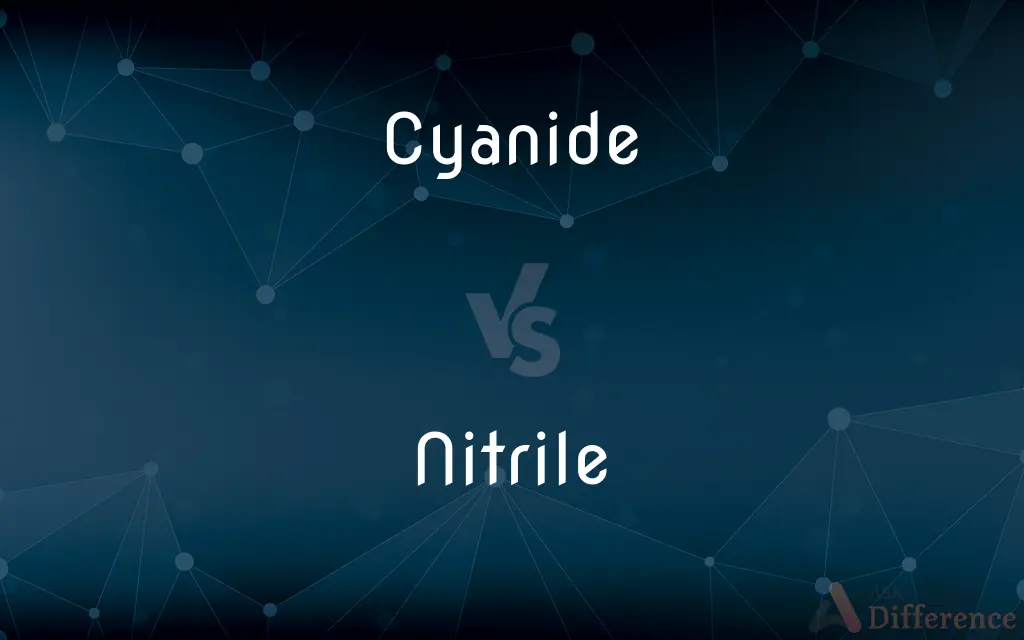Cyanide vs. Nitrile — What's the Difference?
By Tayyaba Rehman — Updated on September 28, 2023
Cyanide is a toxic chemical compound containing a carbon-nitrogen triple bond, while nitrile refers to organic compounds with a triple bond between carbon and nitrogen, often used in making synthetic rubber.

Difference Between Cyanide and Nitrile
Table of Contents
ADVERTISEMENT
Key Differences
Cyanide is an anion composed of a carbon atom triple bonded to a nitrogen atom. Its chemical formula is CN−. Cyanides are infamous for their high toxicity and are used in various industrial applications, including mining and electroplating. In contrast, the term nitrile describes organic compounds that contain a functional group with the structure -C≡N. Nitriles are a broader category, of which cyanide is a part.
When cyanide is mentioned, one often thinks of its poisonous nature. It works by inhibiting cellular respiration, particularly in the mitochondria. This harmful property has made it a subject of concern in various contexts, from environmental issues to its historical use as poison. Nitrile, on the other hand, refers more broadly to compounds containing the C≡N group. Nitriles play a significant role in organic synthesis and are precursors to a variety of useful compounds.
Despite its toxicity, cyanide is utilized in several industries. For instance, it's a vital agent in gold mining, where it helps extract gold from ore. It's crucial to handle and dispose of it responsibly to prevent environmental contamination. Nitrile compounds, particularly those used in making synthetic rubber like nitrile gloves, exhibit resistance to chemicals, oil, and heat, making them valuable in various applications.
In essence, while both cyanide and nitrile feature a carbon-nitrogen triple bond, their context of usage and associated implications differ widely. Cyanide often pertains to the toxic ion, while nitrile is an overarching term encompassing a range of organic compounds, including cyanide.
Comparison Chart
Nature
Anion
Organic compound with C≡N
ADVERTISEMENT
Toxicity
Highly toxic
Depends on the specific compound
Usage
Mining, electroplating
Organic synthesis, making synthetic rubber
Structure
CN−
General form: R-C≡N where R is an organic group
Functionality
Inhibits cellular respiration
Varies; often used in rubber and plastic production
Compare with Definitions
Cyanide
Carbon-nitrogen bond
Cyanide has a triple bond between carbon and nitrogen atoms.
Nitrile
Carbon-nitrogen triple bond
Nitriles contain a C≡N functional group.
Cyanide
Mining agent
Cyanide is used in gold mining to extract gold from ore.
Nitrile
Organic compound
Acetonitrile is a common solvent and an example of a nitrile.
Cyanide
Electroplating substance
Cyanide solutions are often used in the electroplating industry.
Nitrile
Synthetic rubber
Nitrile gloves are resistant to many chemicals.
Cyanide
Toxic anion
Ingesting cyanide can be fatal to humans.
Nitrile
A nitrile is any organic compound that has a −C≡N functional group. The prefix cyano- is used interchangeably with the term nitrile in industrial literature.
Cyanide
Chemical inhibitor
Cyanide disrupts cellular respiration.
Nitrile
An organic molecule containing a CN group, an organic derivative of hydrocyanic acid.
Cyanide
A cyanide is a chemical compound that contains the group C≡N. This group, known as the cyano group, consists of a carbon atom triple-bonded to a nitrogen atom.In inorganic cyanides, the cyanide group is present as the anion CN−. Soluble salts such as sodium cyanide and potassium cyanide are highly toxic.
Nitrile
An oil-resistant copolymer of acrylonitrile and butadiene, used especially for disposable gloves, gaskets, seals, and tubing. Also called nitrile rubber.
Cyanide
The anionic univalent CN group, or any of various salts or esters of hydrogen cyanide containing a CN group, especially the extremely poisonous compounds potassium cyanide and sodium cyanide.
Nitrile
(organic chemistry) any of a class of organic compounds containing a cyano functional group -C≡N; they are named as derivatives of the appropriate carboxylic acid.
Cyanide
To treat (a metal surface) with cyanide to produce a hard surface.
Nitrile
A type of synthetic rubber formed by the copolymerisation of acrylonitrile and butadiene.
Cyanide
To treat (an ore) with cyanide to extract gold or silver.
Nitrile
Any one of a series of compounds bearing the cyanide radical (-CN); particularly, one of those cyanides of alcohol radicals which, by boiling with acids or alkalies, produce a carboxyl acid, with the elimination of the nitrogen as ammonia.
Cyanide
Any compound containing the -C≡N group or the CN− anion.
Nitrile
Any of a class of organic compounds containing the cyano radical -CN
Cyanide
(uncountable) Sodium or potassium cyanide, used in the extraction of gold and silver or as a poison.
Nitrile
Chemical precursor
Nitriles can be transformed into other compounds, such as amines.
Cyanide
(uncountable) Hydrogen cyanide, or cyanide gas, a poisonous gas.
Nitrile
Industrial application
Nitrile-based rubbers are used in automotive and industrial applications.
Cyanide
(transitive) To treat or poison with cyanide.
Cyanide
A compound formed by the union of cyanogen with an element or radical.
Cyanide
Any of a class of organic compounds containing the cyano radical -CN
Cyanide
An extremely poisonous salt of hydrocyanic acid
Common Curiosities
Is cyanide always dangerous?
In high doses, cyanide is lethal, but in small amounts, it's present in many foods, like almonds.
Are all nitriles toxic?
Not all nitriles are toxic; their toxicity varies depending on the specific compound.
Are nitrile gloves made entirely of nitrile?
No, they're made of nitrile rubber, which is a synthetic copolymer.
How does cyanide affect cells?
Cyanide inhibits cellular respiration, preventing cells from producing energy.
Can cyanide be used safely in industries?
Yes, with strict regulations and safety measures, cyanide's industrial use is manageable.
Share Your Discovery

Previous Comparison
Antiseptic vs. Antimicrobial
Next Comparison
Emulsion vs. CreamAuthor Spotlight
Written by
Tayyaba RehmanTayyaba Rehman is a distinguished writer, currently serving as a primary contributor to askdifference.com. As a researcher in semantics and etymology, Tayyaba's passion for the complexity of languages and their distinctions has found a perfect home on the platform. Tayyaba delves into the intricacies of language, distinguishing between commonly confused words and phrases, thereby providing clarity for readers worldwide.














































